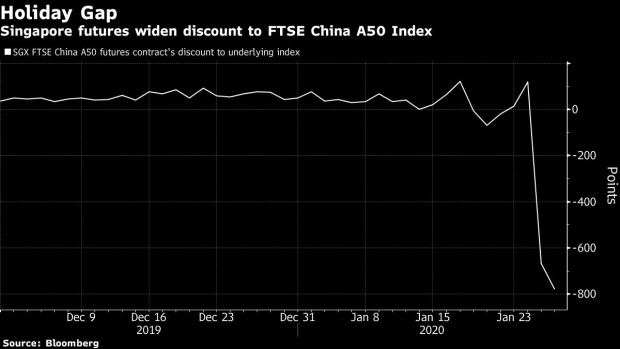Jan 28, 2020
Virus Panic Shows Signs of Abating in China’s Overseas Assets
, Bloomberg News

(Bloomberg) -- Global investors paused their flight from Chinese investments and proxies, suggesting they see less of a case for the sell-off extending even as the coronavirus spreads.
A first sign of easing panic came from the offshore yuan, which rose marginally, after slumping the most in six weeks on Monday. European exchange-traded funds swung between gains and losses and early trading of Chinese shares and depositary receipts in New York signaled less selling pressure.
The move contrasts with declines in most Asian currencies, led by the Malaysian ringgit and Korean won, which may have reflected a catch-up after the violence of the sell-off in European and U.S. hours Monday, when most of Asia was shut for the Lunar New Year holiday. Still, strategists warned against reading too much into pockets of resilience outside China.
“The offshore renminbi is stable today after a large correction yesterday as markets are pricing the slowdown in China’s economy through commodities and equities more aggressively,” said Simon Harvey, a London-based analyst at Monex Europe Ltd. “When onshore markets open, a large correction up towards the 7.00 level is likely.”
Currencies
The offshore yuan rose less than 0.1% to 6.9838, trading about 0.4% weaker than its onshore counterpart’s closing level Thursday. In both markets the currency has closed stronger than the 7-per-dollar level for more than a month. The onshore yuan is scheduled to reopen on Feb. 3.
The ringgit and won dropped as markets in both nations reopened and priced in the coronavirus risk. The Thai baht fell for a fourth day to the weakest level since August.
U.S. Listings
Alibaba Group Holdings rose 0.5% in early New York trading, after posting a 7.6% three-day loss that was the worst since Aug. 5.
Baidu Inc. was up 0.2% in pre-market quotes, signaling the depositary receipts may halt their longest streak of declines since Nov. 20.
JD.com added 0.4%, indicating a higher open after the biggest three-day slump in five months.
Derivatives
The February contract on the SGX FTSE China A50 futures fell, extending its discount to the underlying equity index to almost 800 points. Most of the gap was due to Chinese markets being closed and the difference may be bridged when local exchanges reopen. At the same time, it could offer an arbitrage opportunity for nimble traders.
A measure of bearishness in the options market called skew rose to the highest level since August for two U.S.-listed ETFs investing in Chinese shares. The indicator, which tracks the spread between put volatility and call volatility, surged for both the iShares MSCI China ETF and iShares China Large-Cap ETF.
Short sellers had added $500 million of contracts since Jan. 6, betting that the large-cap fund would see further declines, according to data from IHS Markit.
European ETFs
The iShares MSCI China A UCITS ETF in London, the Lyxor China Enterprise HSCEI UCITS ETF in Paris, and the Xtrackers MSCI China UCITS ETF in Frankfurt swung between gains and losses
To contact the reporter on this story: Srinivasan Sivabalan in London at ssivabalan@bloomberg.net
To contact the editors responsible for this story: Alex Nicholson at anicholson6@bloomberg.net, Paul Wallace
©2020 Bloomberg L.P.


